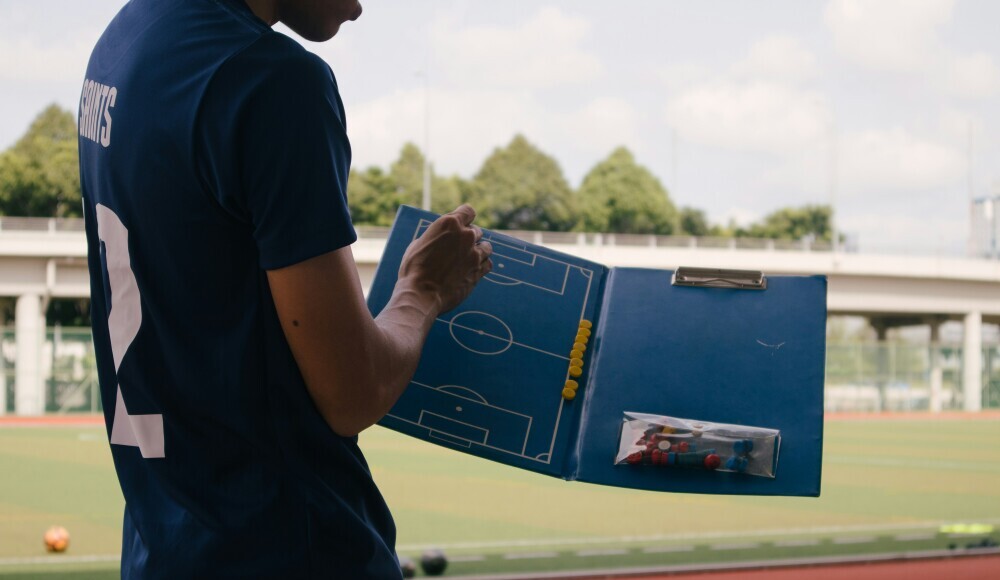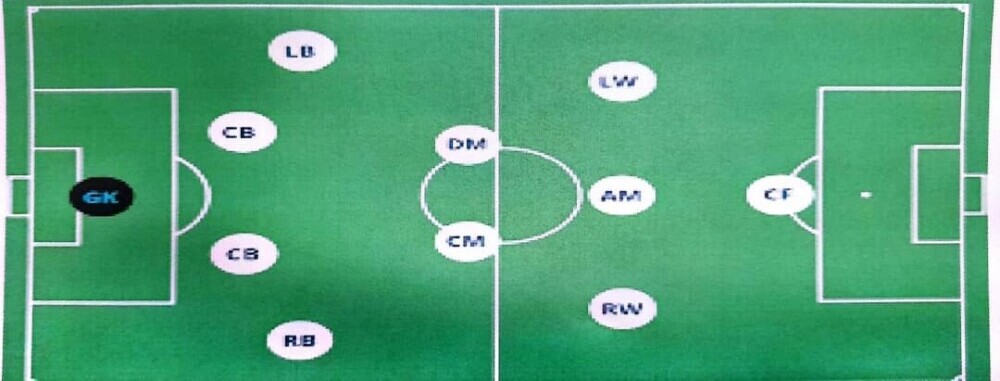Soccer formations are not just diagrams you see before a game; they’re the backbone of a team’s strategy and identity on the pitch.
A coach spends countless hours analyzing players, opponents, and potential scenarios to choose the right formation.
The aim is to harness the strengths of the team while covering its weaknesses, all while keeping an eye on the opponent’s tactics.
Each team and match situation demands a unique approach, almost like picking the right tool for a specific job.
The balance between offense and defense becomes crucial, often dictating whether a team takes a cautious approach or goes all out on the attack.
Player strengths and weaknesses heavily influence formation choices. For instance, having a player with incredible pace might encourage a formation that leverages quick counterattacks.
On the other hand, a strong midfield can be the foundation for controlling possession and dictating the tempo of the game.
Understanding these dynamics and putting them into practice is what separates successful teams from the rest.
With formation choices being as varied as a coach’s imagination, knowing how to adapt and effectively implement them on the field is key to mastering soccer strategy.
Tactical Flexibility: Adapting Formations During a Match
Changing formations mid-game?
That’s where tactical flexibility shows its value. It’s not just a buzzword—it’s an essential skill for any coach or team.
Every match is like an evolving puzzle, and sometimes, the pieces just don’t fit until adjustments are made.
Recognizing when a formation change is necessary can be the difference between winning and losing.
A keen sense of timing and a sharp eye on the field are required. Whether it’s dealing with an overly defensive opponent or needing to add more firepower upfront, formation adjustments can be a game changer.
But switching things up isn’t just about spotting problems. It’s also about maintaining team structure and ensuring players know their new roles.
It can be challenging, like trying to solve a Rubik’s cube under pressure, but when done right, it’s a sight to behold.
Substitutions play a critical role here.
They’re not just about fresh legs but also about bringing tactical advantages. The right player at the right time can transform a formation change from a risky move to a stroke of genius.
Understanding how to effectively use substitutions to unlock your team’s potential is an art in itself.
Lastly, anticipation of the opponent’s tactics is vital.
Coaches with a knack for reading the game can outwit their adversaries, ensuring that formation changes are proactive rather than reactive.
This proactive approach keeps the team on the front foot, ready to tackle any challenges that come their way.
Analyzing the Game Situation: Key Indicators and Considerations
Understanding the game is like tuning into a live broadcast of constant updates and potential.
It’s not just about reacting to the here-and-now; it’s about shaping what’s coming next.
Evaluating a formation’s effectiveness is essential, and there are short-term clues to look for: are we holding the ball well?
Creating more opportunities?
Do players look comfortable in their spots? These signs give immediate insight into how a formation switch is impacting the game.
There’s more to it, though.
Looking at a team’s consistency over a series of matches, observing injury rates, and assessing how well players are adapting paints a bigger picture of whether tactical shifts are paying off in the long run.
In-game decisions aren’t just about what’s on the scoreboard.
It’s about feeling the flow— is the team controlling it or getting swept aside?
Watching opponent reactions can tell you volumes too; if they’re scrambling, your formation tweak might’ve hit just the right note.
A coach’s job is a mix of presence and foresight, ensuring tactical shifts not only respond to the moment but also align with broader objectives.
This balance between reactive and proactive adjustments keeps a team not just playing, but excelling.
Risks and Challenges: Navigating Mid-Game Formation Changes
Switching formations during a match is not without its pitfalls.
It can be a thrilling strategy, but it also opens up a box of potential hazards. Recognizing these risks in advance helps in navigating them better.
Player confusion can be the first bump in the road.
Shuffling roles and responsibilities might lead some on the pitch wondering where they’re supposed to be next.
Clear communication from the sideline is essential to keep everyone on track.
Another issue is disrupting the team’s natural rhythm.
The flow of the game can be delicate, and sometimes a tactical tweak can jar the team’s cohesion, resulting in unintended consequences.
Physical demands should never be underestimated.
Changing formations can ask different things of players, whether it’s ramping up their intensity or positioning them differently on the field.
This can lead to fatigue or, worst-case scenario, injuries if not managed correctly.
Handling substitution wisely is key too. There are only so many you can make, and wasting them on risky formation shifts can backfire, especially if a key injury occurs later in the game.
Keeping morale high is crucial. Abrupt formation changes can make players uneasy if they sense it arises from panic rather than a planned strategy.
Confidence in the game’s plan can make or break formation-driven success.
Understanding and preparing for these challenges means having a keen plan for formation shifts, ready to adjust both to the demands of the game and the needs of your players.
Success Stories: Case Studies of Mid-Game Tactical Innovations
Switching formations mid-game can sometimes lead to stunning victories. Looking at examples from teams who’ve done it right offers a wealth of learning opportunities.
UEFA Champions League/Europe
- Liverpool vs. Barcelona (2019): Down 3-0, Liverpool adjusted from 4-3-3 to 4-2-3-1, utilizing Jordan Henderson’s box-to-box midfield role, securing a 4-3 aggregate comeback.
- Chelsea vs. Bayern Munich (2012): Trailing 1-0, Chelsea shifted from 4-3-3 to 4-1-4-1, congesting midfield, and won 5-3 on penalties.
- Manchester United vs. PSG (2019): United switched from 4-3-3 to 3-5-2, exploiting PSG’s narrowness, winning 3-1.
What looked like a hopeless stalemate turned into a win by shifting to a more attacking setup. This shift carved out precious chances, turning the tide and etching out crucial goals.
Then there are the following teams who noticed their rivals’ high defensive line offered ample room for counterattacks.
FIFA World Cup
- Germany vs. Brazil (2014): Germany adjusted from 4-2-3-1 to 4-1-4-1, overwhelming Brazil 7-1.
- Spain vs. Netherlands (2014): Spain shifted from 4-3-3 to 4-1-4-1, controlling midfield, winning 1-0.
By adjusting their formation to exploit this, they quickly sent attacking players darting through gaps, catching the opponent napping and netting quick goals.
La Liga/Spain
- Barcelona vs. Sevilla (2018): Barcelona switched from 4-3-3 to 4-2-3-1, controlling midfield, winning 2-1.
- Real Madrid vs. Atlético Madrid (2014): Real Madrid adjusted from 4-3-3 to 4-2-3-1, exploiting Atlético’s narrowness, winning 4-1.
Adapting their formation to focus attacks on the wings, they eventually breached the defense, scoring when it mattered most.
Serie A/Italy
- Juventus vs. AC Milan (2016): Juventus shifted from 3-5-2 to 4-4-2, exploiting Milan’s wingbacks, winning 2-1.
- Napoli vs. Roma (2018): Napoli adjusted from 4-3-3 to 3-4-3, dominating possession, winning 2-1.
These examples are more than just fun anecdotes—they’re blueprints highlighting how calculated formation changes can unlock new avenues of play and turn seemingly tough matches in your favor.
Tactics Employed
- Midfield congestion: Packing midfield to disrupt opposition possession.
- Wingback exploitation: Targeting opponent’s vulnerable wingbacks.
- Striker isolation: Isolating strikers to create scoring opportunities.
- Defensive solidity: Switching to defensive formations to protect leads.
- Counter-attacking: Quick transitions from defense to offense.
Take away
Tactical flexibility is key to success in modern soccer.
By understanding game dynamics, anticipating opponents, and adapting formations, coaches gain a competitive edge.
Apply these insights, refine your strategy, and elevate your team’s performance.
Please leave your message in the comment section below and I promise to come back to you.
Happy analysis!!!!!!!!!!!
Happy soccer season!!!!!!




Great read! Your article really captures the strategic depth of soccer formations and how they can make or break a game.
I especially liked the real-life examples of how teams have turned games around with a strategic shift. It’s fascinating to see how a formation change can exploit an opponent’s weakness or boost your team’s strengths!
Fascinating deep-dive into formation flexibility! Your Champions League examples really caught my attention, especially the Liverpool vs. Barcelona (2019) tactical shift. I’m curious though, in today’s high-pressing game, do you think the 4-2-3-1 formation is becoming more of a defensive liability? I’ve noticed teams struggling to transition quickly enough when losing possession in this setup.
Also, while you’ve covered the successful formation changes brilliantly, I’d love to hear your thoughts on some famous formation switches that backfired. Do you think there’s a “golden timing” for when to make these tactical changes during a match?
Your section on player confusion during formation changes resonated with me. As someone who follows tactical analysis closely, I’ve often wondered: what communication methods do you find most effective for coaches to convey formation changes mid-game? The traditional hand signals seem somewhat limited for complex tactical shifts.
Looking forward to your insights!
Thank you for your insightful comment and for bringing up some fantastic questions!
I’m thrilled you enjoyed the Liverpool vs. Barcelona (2019) example—it’s such a masterclass in tactical flexibility, isn’t it?
Let me dive into your points:
The 4-2-3-1 Formation in Today’s High-Pressing Game:
You’re absolutely right that the 4-2-3-1 can sometimes become a defensive liability, especially in the face of aggressive pressing systems. The issue often stems from the pivot midfielders (the two in front of the backline) getting overrun when the team loses possession and struggles to reorganize quickly enough. Without quick and disciplined transitions, this setup can leave the defensive line exposed.
That said, it really depends on how well the team executes the structure. For instance, if the pivot players are highly mobile and the wide attackers (in the “3”) track back effectively, the 4-2-3-1 can still hold up well. But yes, in an era where pressing is king, it’s becoming less forgiving for teams that aren’t well-drilled in transitions. What are your thoughts—have you noticed specific teams struggling with this setup recently?Famous Formation Switches That Backfired:
I love this idea! One famous example that comes to mind is Argentina vs. France in the 2018 World Cup Round of 16. Argentina’s mid-game shift to a highly attacking formation left their defense completely exposed, and Mbappé exploited the space with blistering counterattacks. Another notable one is Tottenham’s shift to a back-three under Mourinho against West Ham in 2020, which disrupted their defensive shape and contributed to a 3-3 collapse.
As for “golden timing,” I’d say there’s no one-size-fits-all answer, but making a tactical change early enough to impact the game (while still giving players time to adapt) is key. Often, the 60-70 minute mark works well if chasing a result. But if it’s reactive, like defending a lead, earlier adjustments at halftime can be critical. Do you have any formation changes in mind that didn’t go as planned?Communication Methods for Mid-Game Formation Changes:
Great question, and I agree—traditional hand signals can feel limited for more complex tactical shifts. Some methods I’ve seen work effectively include:
Pre-match Preparation: Coaches often prepare players for multiple scenarios and communicate clear “triggers” for when a formation switch might happen. For example, “If we’re trailing in the final 20 minutes, we’ll push to a 3-5-2.”Utilizing Captains and Leaders: The captain or experienced players on the pitch can help convey instructions more effectively, especially when verbal communication isn’t possible.Sideline Boards/Tablets: Some coaches use small whiteboards or digital tablets to quickly sketch out new formations and send them with a substitute or relay them during stoppages.Pre-planned Hand Signals: While basic, they’re often paired with verbal cues shouted to individual players. For instance, Klopp’s team uses a mix of gestures and simple phrases like “line higher!” to adjust.
I’m curious—do you think technology like wearable devices could one day allow coaches to communicate tactical shifts more directly to players?
Thanks again for such thought-provoking questions.
Looking forward to hearing your thoughts on this!
Tactical analysis is such an exciting area to explore, and these conversations are what make it so fascinating.